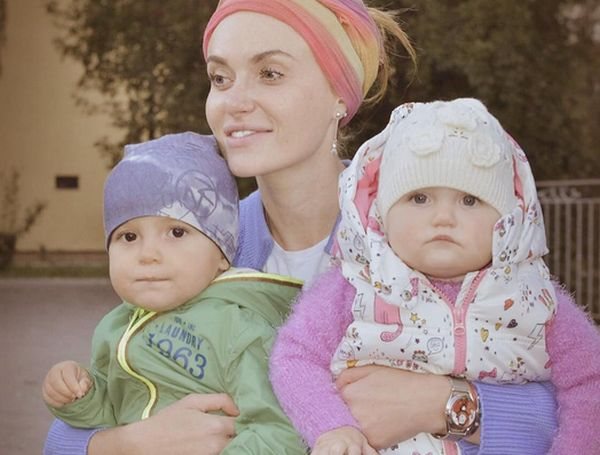Advantages of simultaneous training and education
Raising and teaching children of different ages is a complex and interesting process that has more advantages compared to teaching and raising children of different ages. This is especially felt when the difference exceeds 5 years. Children with a difference of up to 2 years go through periods of crisis together, which allows parents to solve all problems at the same time. Among the most prominent positive aspects of growing up at the same time are:
- Similar mode. After the youngest child turns 1 year old, the daily routine of both children becomes very similar, which makes it possible to plan activities and walks for both offspring with the greatest benefit. When the difference is greater, it will not be possible to synchronize the kids so much; the difference in development will require parents to adjust modes and seek compromises more often than with children of the same age;
- Same educational institutions. Children often attend the same kindergarten, go to the same class, and study groups, which reduces the number of tasks for parents to solve. You need to attend one parent meeting, not two, one matinee or event, payment, purchase of office supplies and other necessary items go according to a common list for both children. When the kids grow up, they will be able to return from school together and parents will be calmer;
- The speed of development of the youngest child. The younger one, watching the older one, quickly learns the necessary skills, strives to imitate and achieve success. By exploring the world together, children quickly learn the principles of communication and options for resolving conflicts;
- Mom's experience. She already has enough experience to care for her second child faster and better. She can predict possible nuances and behaves more confidently;
- Selfishness and jealousy. Children the same age, smaller than children with a larger difference, are jealous of their mother and show selfishness, because from a young age they get used to the fact that there is someone nearby whose opinion must be taken into account;
- Features of training. In families where children are growing up the same age, learning is easier: the younger one, watching the older one, gets involved in classes, remembers the material, and develops on an equal footing with the older one;
- Adaptation. Children from families where there are older people adapt faster to society. Most often, children end up in the same group in kindergarten or even the same class at school, which allows them to overcome the difficulties of adapting to new circumstances with the support of each other;
- Friend and colleague in games. Kids the same age, growing up, find common activities and can keep each other busy. Often, babies with a small age difference prefer to read, write, and draw together, freeing up mom’s time and developing faster;
- Saving. If the children are of the same sex, then many of the things that the older one wears can immediately go to the younger one, the same goes for care items. Growing up, children can change things, choosing the desired image. But this plus only works if you attend different classes; in the opposite situation, this can become a problem;
- Mastering self-care skills. Children the same age show independence faster. The older one is forced to grow older faster, and the younger one stretches out, seeing an example;
- Schooling. Often the same year falls into the same class, which allows you to create a spirit of rivalry and competition. This situation has a beneficial effect on learning and development. If parents do not put pressure and do not compare the children’s successes, healthy competition does not have a negative connotation and encourages both to achieve better results;
- Free time for mom. With a properly organized daily routine, after the youngest child reaches 1.5 years old, there will be more free time thanks to children playing together. They will be able to keep each other busy and find fun and interesting activities on their own if adults suggest options.
Disadvantages of simultaneous education and training of the same age
Not everything is so smooth when training the weather; various undesirable consequences may appear at different periods. Most often noted:
- Difficulties in learning when going to school late. Sometimes, when children of the same age are placed in the same class, one of the children may have difficulties due to a discrepancy between his development and the program. If the eldest goes a year later, then he may be bored and may outgrow the interests of his classmates. By sending your youngest child to school a year early, without assessing the level of readiness for the school curriculum, you can end up with a child who cannot cope with the proposed workload, which is why he shows reluctance to learn or develops an inferiority complex. To avoid such situations, you need to carefully weigh the pros and cons of enrolling in school at the same time;
- Insatiable curiosity. The training and upbringing of children of the same age is complicated by their enormous thirst for knowledge. One child constantly explores space and strives to reach and climb everywhere, which can put the mother in a stressful state. When there are two small children in the house, the parents’ vigilance should be doubled, because the older one can help the younger one get to forbidden places, incite them to do unreasonable things;
- Conflicts. Children of the same age, for all their friendship, until they grow to a meaningful age, can often not only argue, but also fight, bite and try to take each other’s toys. Patience, constant calm explanation, and equal treatment of both children come to the aid of parents;
- Unhealthy competition. With an uneven distribution of time between children and a comparison of their abilities and achievements, a fierce struggle for the attention and love of parents may occur. Children can show aggression, gloating, try to expose each other to punishment, which does not contribute to the formation of warm relationships;
- The need for outside help. Raising two children with a small age difference requires constantly seeking help from other people, which is not always convenient or easy to do. It’s good if grandparents no longer work and live nearby, they can help with the older child at the first stage, in the opposite situation, serious responsibility and burden falls on the mother’s shoulders;
- Same toys and equality in shopping. Often, to avoid conflict, parents have to buy the same toys, things, and creative items.
Most negative manifestations are easily overcome by changes in the behavior of adults in relation to the weather. A thorough analysis of actions and relationships between children will help parents not only correct undesirable consequences, but also prevent possible actions.
Children of the same age are all advantages
Children of the same age are often close friends. They play together, go to the same kindergarten and go to school almost at the same time. This makes it easier for them to adapt to a new environment.
In order for children to quickly make friends and fall in love with each other, there is no need to interfere with their communication. Very often, parents do this out of fear that the elder may harm the baby with an awkward movement. But under adult supervision, such communication will be safe and very useful for both children. And if the older child helps you take care of the younger one, give you a bottle, rock a stroller or crib, affection will appear much earlier.
Of course, the first year after the birth of your second child will not be an easy period. During this time, children's developmental processes will be very different. The elder begins to actively explore the world, discovering something new every day. And the younger one cannot yet join him in this.
In addition, the firstborn still remembers that just recently he had your undivided attention. And the appearance of a new child in the mother’s arms causes jealousy and resentment. But over time, these problems will resolve themselves.
The older child forgets that he was once the only one. He becomes interested in playing with the grown-up baby, teaching him to walk, talk, and play with just toys. And the youngest learns everything very quickly.
When people get older, the small age difference, which caused so many problems at first, becomes very convenient for both children and parents. Children will have common interests and activities.
The older one will forget the time when he was an only child and will remember how he grew up with the younger one, so there will be less jealousy and rivalry between the children. They will grow up less selfish, get used to sharing everything and taking care of each other. It will be easier for them to share one room.
The cash costs for things for the second child will be minimal, because after the eldest they will not have time to go out of fashion. The same age can be sent to school at the same time. They can study in the same class, grow and mature together. During adolescence, it will be easier for the two of them to cope with emerging age-related problems. They will trust each other with their secrets.
Features of raising children of the same age
When there are two children in a family with a difference of up to 2 years, the mother has to spin around and look for options on how to teach and develop the kids in accordance with their needs, devote enough time, without becoming a “lathery” horse herself. We have collected popular secrets of organizing everyday life and teaching the weather, which will help you solve the issue of raising and educating children.
From the birth of the youngest to one year
The first period of organizing the education of two children begins with the birth of the youngest child and lasts until he reaches 1 year. This is the most difficult period of time in organizational terms, which requires a lot of effort from the mother to normalize the process and make it useful. The main problem is the need to devote a large amount of time to the second child, while the eldest requires no less attention. Often, feeling the novelty of his position, the firstborn shows nervousness, capriciousness, and behaves unusually, demanding a return to his former 100% attention.
How to act in such a situation so that the younger one does not cry, and the older one does not feel abandoned? There are several simple techniques that will definitely help you.
Schedule
The main salvation for a mother of the same age at the first stage is a clear schedule for both children. If you prepare the older one for a certain rhythm of life during pregnancy, and do the same with the younger one, all the necessary tasks can be done while the younger child is sleeping or during the older child’s independent activities, using a sling to entertain the baby. It’s good to combine a walk with the older one and rest for the younger one. While reading books or looking at various educational materials, hold your little one in your arms or place him nearby on a special rug. The older child is at an age when daytime sleep is very important; if you combine schedules and put both babies to sleep during the day, you can lie down and rest yourself.
Weaning a senior off the bottle and pacifier
A separate issue that makes life easier for a mother with two children under 2 years old is the use of pacifiers and bottles. To normalize this process, experienced mothers recommend accustoming their firstborn to a mug and weaning it off the pacifier before the age of one year. The baby will learn new things with interest, and you won’t have to struggle with trying to take away the desired pacifier or bottle.
To accustom your firstborn to a mug, it is advisable to use a plastic version of a bright color that attracts the baby. You can invite him to independently choose an object to drink or a plate to eat. It is advisable to do this before the arrival of the youngest child and tell the baby how proud you are of his new skill, how glad you are that he is already so big, can drink from a mug and eat like his parents. A sense of self-importance and skill will give the child courage, self-confidence, and stimulate the desire to develop.
Security measures
Separately, it is worth paying attention to ensuring safety for both children. In this case, it is necessary to take into account the increasing capabilities of the first-born and the lack of intelligence of the younger. Preparing an apartment for the stay of two children of the same age can be divided into two areas:
- Creating a safe environment for older children to play. This part of the work includes not only plugging sockets and clearing the room of fragile, breakable objects, but also a thorough analysis of the entire area for dangerous places that the baby can climb into while the mother is distracted by the youngest child. Check all the shelves not only at your baby's eye level, but also those that he can reach using chairs or other furniture. Children from 1 to 3 years old actively explore the surrounding space and strive to conquer heights, developing their own dexterity and physical fitness. You may not notice how quickly the baby climbs onto a chair, then onto the table. Temporarily excluding light chairs and stands from view and moving furniture away from the window will help avoid unwanted falls and injuries. Separately, it is worth checking that all household chemicals are in hard-to-reach places and are carefully closed. To make the apartment safer for an older child, you need to think, following the logic of the little one. Bright and unusual objects that are frequently used attract the child's attention, so you should carefully consider the possibility of playing with them;
- Precautions with infants. Do not forget to check the safety of the younger child, and carefully ensure that the older one does not inadvertently cause him pain or injury. Often, with the appearance of a little person in the house, firstborns strive to show their cordiality, try to share toys, play or touch, while the parent should always be nearby and show in a soft, unobtrusive manner how to properly handle the baby. Do not leave children alone in the same room, even when the baby is sleeping in a crib. The first-born may want to climb into the crib, throw a toy in there, or just rock it. Children of preschool age cannot yet assess the possible consequences of their actions.
Extra attention to the elder
From the moment a second child appears in your life, you need to try to pay as much attention as possible to the older baby. He still needs his mother very much, so it is necessary to provide him with enough time. While the younger one is awake, you can use a sling, read a book to the older one, play with him, assemble a construction set and talk a lot. Your attention to his activities and interests at this stage is very important, it allows you to feel your love. When the younger child is sleeping, do not be afraid to wake him up, your voice soothes and lulls him to sleep, so feel free to talk to the older child in a calm manner.
Don't forget to tell your firstborn about your love. Psychologists say that every child must hear at least 7-8 times a day about their parents’ love in order to feel it.
If the youngest is capricious, he is worried about colic, teeth or something else, then you should not forget about the older child during this period. Review your activities together and focus on quality rather than quantity. You shouldn’t tell your firstborn to “leave me alone,” “do something,” or “you understand that I’m busy.” The baby will not yet understand your words about workload or the need to constantly take care of the younger one, and words that do not offer a specific activity or have an aggressive connotation can deeply hurt the baby. You need to try to remain calm, be good-natured and attentive not only to the problems of the baby, but also to the feelings of the older child. Without receiving your attention, the firstborn will feel useless and abandoned, which will affect the pace of his development.
The period from the birth of the second child until the moment when he walks and can actively explore the surrounding space is the most difficult time in a mother’s life. The younger child is very time-consuming, as is the older child, and it is quite difficult to organize the day to satisfy each of them. You should be encouraged that this period will not last long and soon everything will become much easier, the children will be able to play among themselves, and you will breathe a sigh of relief.
From 1 to 3 years
After the youngest child starts walking, everything will gradually improve and will gain order and stability. The older one will be interested in watching the younger one. Around the age of one and a half years of the second child, the kids will begin to have common activities and games. By observing the elder, it will be easier for the second to master the necessary skills and strive to repeat after him.
At a certain period, it may seem to you that you are not the same age, but twins or twins, so they will be similar in their habits, but there is a danger behind this. If you have children with a small age difference, do not forget that there is one. Do not compare opportunities and achievements, do not show that one of them is better or worse. The main secret of raising and teaching children of the same age is equality. The spirit of healthy competition appears where children see equal treatment of themselves, feel important to their parents and understand that no one is being singled out.
Separately, during the second period of growing up, you need to think about the issue of personal space. Every child, like an adult, needs his own corner where his things will be located, where he can spend his free time and do what he loves. If this is not yet so relevant for the younger one, then the older child already needs it. It is necessary not only to organize it, but also to ensure that the younger one tries not to violate boundaries.
The older child increasingly demands a variety of activities, knowledge and stories about all surrounding objects. After he reaches 2 years old, you can think about organizing a training place and classes where you will teach him a variety of skills and drawing. It’s good if there is a place nearby that can comfortably accommodate a younger child (high chair, ottoman). During classes, it is good to invite the younger one to do something similar to the action of the older one. If you draw, then prepare two sheets of paper, on one show the technique to the firstborn, and on the other give the younger one the opportunity to draw with a different pencil or chalk. When reading to the older one, be sure to take the younger one with you, give him the opportunity to look at the pictures with you, and poke his finger into the book.
After a year, the organization of education and upbringing is based on the principle of simultaneous classes, the sleep and wakefulness schedule is almost the same, which allows you to plan developmental activities, walks and joint games for both kids.
The third period of growing up (from 3 to 7 years)
At about three years old, a child begins to show an active interest in learning, so when the time comes for an older child to learn, it is necessary to offer him the maximum. But don't forget about the younger one. When explaining new material, showing interesting pictures or giving tasks, involve your younger child. He will definitely become interested and remember new information. Training in tandem will stimulate the older child to show his intelligence, superiority in capabilities over the younger one, and the subsequent training of the younger child by the older child.
The only thing to be wary of when simultaneously teaching the same age is comparing children of different ages. Never talk about the difference in achievements between the two, they are different, they have different opportunities and conditions. Even if the younger one shows great abilities, never set him up as an example to the older one. There is no need to try to compare the speed of mastering certain skills by age. Children of the same age are different from each other, they are different people and each of them has their own way of understanding the world.
When teaching children together, you cannot give them exactly the same tasks without focusing on their age. So you may not calculate, give the elder a task that is too easy, which will cause him boredom, or offer the younger one a task that is too difficult, he may not be able to cope and think about his inability. It would be optimal to prepare similar tasks that differ in complexity.
Circles and sections
After three years, for many parents, the issue of child development with the help of clubs and sections is important. When the weather in a family grows, you should not immediately send both of them to the same direction. This should be the direct desire of the child himself. If the baby doesn’t like it or doesn’t want to attend the same section as his brother or sister, don’t insist. It’s better to ask which direction he likes. Children with a small age difference, having similar interests, are different people, and if one draws well, it does not mean that the other will be delighted with such an activity.
Another issue that concerns mothers of similar children is organizing visits to a large number of clubs and synchronizing the schedules of children with different interests. When each of the kids attends 2-3 clubs, their life becomes like an endless movement between different sections, waiting for their brother or sister to finish their classes, an eternal race against time, trying to do everything. In pursuit of a variety of knowledge offered by developmental schools and clubs, mothers often forget about the need for children to have free time spent playing simple games. If you really want to attend developmental classes, then it is optimal to limit yourself to one circle for each child, and devote the remaining time to home learning and play.
What else you need to know when raising children
Circle of friends
Children's social circles may vary. Similar children easily find a common language with other children, but they are not a copy of each other and what one likes and suits may cause discomfort to another. It is worth paying attention to the needs of the little person and trying to provide him with the necessary conditions. You need to try to look for not a single approach to both children, but an individual one in order to help them. If for some reason the company of one child is not liked by another, you need to help him acquire his own friends.
Often one of the weather is stronger in spirit. It is he who becomes the driving force in the development of both, and this is not always the eldest child. It is important for parents to help the weaker in tandem find their own purpose, hobbies, and path of development. Don’t leave everything to chance, the baby will grow up, and if he has blindly followed another child all the time, he will have difficulties with the choice that has always been made for him. Talk not only with both children, but also find time for heart-to-heart conversations with each of the children alone.
Disputes and compromise
A separate issue in raising children of the same age is teaching them how to find compromises in a conflict situation. You should not one-sidedly teach the elder to always give in to the younger, contrary to his own desires. Each situation requires careful consideration for fairness. In some cases, it is necessary to show attention to the needs of the elder, inviting the younger to yield.
Preschool children have a heightened sense of justice, and if they do not feel it in relation to themselves, they develop various complexes: from a feeling of uselessness and unimportance for their parents to acute forms of aggression towards the offender. In a conflict situation, if you were not a direct witness to the beginning of the dispute or do not know what the reason for the disagreement is, you should not immediately blame and punish the one who commits the wrong action. There is a possibility that this happens as a consequence of actions on the other side. If you punish one, and the other gets away with it, then the punished person will perceive the situation as unfair, may harbor a grudge, and the real culprit of the conflict will perceive his behavior as normal and, when the opportunity arises, will notify you about the wrong actions of his brother or sister, omitting his role, as normal behavior.
The fight against complaints against each other in families with children of the same age is a pressing issue, ambiguously perceived by parents. Having a sneaky child makes it easy to control the situation, but this can negatively affect the relationship between children. It is worth trying to fight such behavior and teach to protect each other, wish well and try to help in word and deed.
Empathy
It is important, along with healthy competition, to teach children the ability to admire the achievements of a brother or sister, to see the beauty in their actions and creations, and to teach them how to cheer them up in a difficult situation. Children of the same age will grow up to be friends if they see in their brother or sister not only a competitor, but also a loved one whom they can trust and tell about their successes. This will help you overcome many difficult life situations that lie ahead. If children know how to enjoy each other’s successes and strive to understand and help, it will be easier for them to go through the difficulties of adolescence and the hardships of adulthood hand in hand.
Safety
When teaching the weather, do not forget about safety lessons. When a mother goes out for a walk with two children over 3 years old, it’s good if they know how to behave and listen to her commands. The best option would be if, along with mother’s lessons, other relatives also teach safety rules and tell the little ones that they need to stay close to their mother, obey her unquestioningly, and follow the traffic rules. This way, children will understand that mother’s lessons are an obligatory truth, which is confirmed by everyone around them, and they will try to obey and behave correctly.
Raising children with a small age difference is a process of constant analysis of the situation, the desire to teach and educate based on age and abilities, the desire to convey the importance of good relationships. All these efforts are justified and allow us to raise good friends and loyal comrades from children of the same age!
If you liked the article, please share a link to it
Similar articles:
The weather is not twins
It would seem that the difference between children of 1-2 years is so unimportant that they can be raised in the same way as twins - always together, wearing the same clothes, and what is even more convenient - the younger one can wear the clothes and shoes that the older one grew up with. But psychologists assure us that this is the main mistake that parents of the same age make. The fact is that for preschoolers, the difference of 1-2 years is very significant physiologically and mentally, unlike babies who were born on the same day. A three-year-old, for example, is already quite capable of mastering a story-based game and communicating with peers, but a one-and-a-half-year-old baby is not yet mature enough to play such games.
Of course, they will spend a lot of time together and over time they will be interested in playing together, but do not forget about the interests and capabilities of the younger one. True, the youngest of the same age often develops faster, because he constantly sees an example in front of him to which he must strive. Thus, the zone of proximal development of the little one expands thanks to the older one.
Remember to give individual attention to each child, taking into account their developmental level and capabilities. This is a sure way to avoid chronic and painful competition and jealousy between them.

instagram @babaslavka












